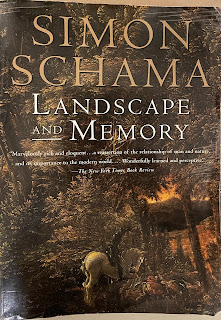Landscape and Memory
by Simon Schama
New York: Vintage Books, 1996
ISBN: 0-679-73512-7
(Amazon)
Read by the author in Nov. 2023, purchased for $7.36
"But his wife looked back from behind him, and she became a pillar of salt." (Genesis 19:26)
(ותבט אשתו מאחריו ותהי נציב מלה.)
In his book Antiquities, the Jewish historian Josephus retells the story of the destruction of Sodom, recalling that Lot's wife was "changed into a pillar of salt." He then adds of the pillar, "For I have seen it, and it remains to this day." (Antiquities 1.203) Slightly earlier, the author of The Wisdom of Solomon referenced this story as well, writing: "Evidence of their wickedness still remains: a continually smoking wasteland, plants bearing fruit that does not ripen, and a pillar of salt standing as a monument to an unbelieving soul." (Wisdom of Solomon, 10.7)
Rabbinic texts make similar references with religious implications, ruling that upon seeing Lot's wife one must praise God. (Babylonian Talmud Berakhot 54a) Theologians and explorers continued to discuss Lot's wife as an existing site throughout the Middle Ages and today modern scholars like Katherine Low discuss how it remains a resonating cultural touchstone.
Simon Schama's exquisitely-written book, Landscape and Memory, discusses this exact phenomenon, showing how landscape can play a generational role in the ethos of a nation. Schama, a renown historian, divides his book into three main categories: wood, water, and rock. For example, he demonstrates convincingly how the forest (both as a trope and as a physical feature) played an important role in German culture, appearing in high literature and folk tales, in law and military struggles, as a through line in history. So, apparently, did the species of European bison. Similar points are made about rivers (including the Jordan and the four rivers of Eden), mountains (with a great discussion about Mount Rushmore), and a fascinating story about Claude Francois Denecourt, the father of all hiking trails. These are all described in prose that leaves one exhilarated and perhaps a little jealous.
When compared to the sedentary nations of Europe, we wandering Jews are at a bit of a disadvantage in this regard. Although we have plenty of hassidic tales set in generic forests, or legends about Jews arriving in Poland and seeing "po lin" ("stay here" in Hebrew) inscribed on the trees, we have for centuries been detached for a specific place in the world, and therefore cannot accumulate the type of intense history shared between Germany and the Black Forest. This despite Schama's amazing stories (and picture!) of his great-grandfather and other the Jewish Lithuanian lumberjacks. As he quotes historian Isaac Deutscher, "Trees have roots. Jews have legs."
But perhaps this isn't strictly necessary, and the physical bond can be circumvented with a deep connection to literature and national memory. Though separated from the Land of Israel for scores of generations, there remained a sense, a memory, of the landscape as described in the Bible and Talmud, of the caves of Ein Gedi, the cliffs of Masada, wind in the mountains of the Carmel, the bears of Bethel, the shores of the Lake of Galilee, fire beacons on Sartaba, and the Temple Mount. Was the connection in the Diaspora less for having not walked these sites? Yes, but not so much so that upon returning to the land after thousands of years they could not be refreshed, where traipses on trails through the Judaean Hills past the remains of wine and olive presses seem just like pouring over pages of the Mishnaic order of Zeraim, where the same agricultural installations are encountered.
Schama starts his book with a tale of collecting sixpence as a lad in cheder to buy trees for the Jewish National Fund, picturing the cedars of Solomon and envisioning the Galilean soil. This connection remains, though the disconnect means that Schama describes the date of Tu bi-Shevat as arbitrary, rather than realizing it is when trees begin to flower in Israel, marking a new cycle of growth and a logical cut-off date for the arboreal tax year. He discusses date trees in connection to crosses, but at the same time quotes Pliny repeating "stories of palms that perpetually revive themselves." This brings to mind the famous "Judaea Capta" coin minted by the Romans after the conquest of Judaea and destruction of the Temple, remembered for millennia such that in 1958, the Israel Mint cast an "Israel Liberata" coin with the same imagery, and several decades later the Arava Institute revived Judaean dates from seeds found at Masada, resulting in a date tree dubbed Methuselah and several other miraculously reborn trees. Landscape and Memory, indeed.
The author writes in conclusion that "Whether we scramble the slopes or ramble the woods, our Western sensibilities carry a bulging backpack of myth and recollection." There is no doubt that this is true, and for Jews no less.
See my book, ArchitecTorah: Architectural Ideas in Judaism and the Weekly Torah Portion for essays on ruins, the four rivers of Eden, witness trees, anchorite monks, pillars of salt, and more.

Comments
Post a Comment